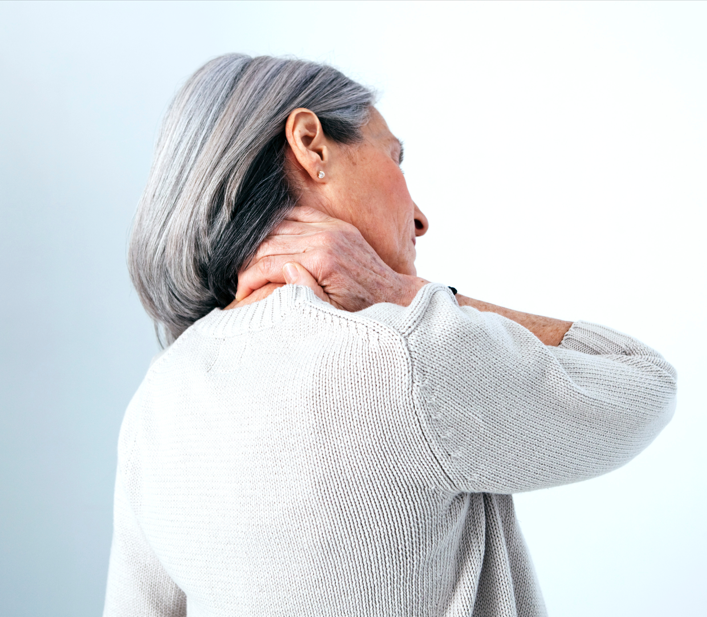Three Common Neck Problems
Neck pain is one of the top five reasons patients come to our practice for help. There are several neck problems that we see commonly and the treatment for each of these problems is different. In this blog I describe three common neck problems that we see every week in our practice and give an overview of the treatment of each.
Joint Pain in the neck
The neck, or cervical spine, is made up of seven vertebrae stacked one on top of the other. These are named C1 through to to C7, with the skull resting on the top most vertebra, C1. These vertebrae are connected to each other via small facet joints on each side, which means there are a total of 14 facet joints in the cervical spine.
These facet joints have the same basic elements as your knee, hip or shoulder, and just like those joints, can become swollen and inflamed. They can also become stiff if not used regularly, and you can develop osteoarthritis in these small joints just like you can in your knee or hip.
Joint or facet pain in the neck is very common and typically presents as pain on one side of the neck. This could be localized to one part of the neck, but referred pain to the shoulder blade is very common for facet joint pain. These patients have difficulty moving their neck in certain directions, with turning and looking up often being painful to the patient.
These patients need structured treatment to restore pain-free movement in the joints of their neck. This includes very specific exercises targeting the affected joints, plus specific hands-on techniques to encourage movement in the right direction. Treatment progresses over 4-6 sessions and if done well, most patients are able to reduce their symptoms, restore full movement in their neck and resume their normal activities. It is worth saying that the home exercise program, which is usually or 2 exercises only, is completed daily (this is a common reason patients fail treatment).
Postural Neck Pain
Postural neck pain, as the name suggests. comes about from spending too much time in one position. For the neck, this usually means sitting too long. This could be at your workstation, in your car or perhaps when doing craft at home. From a physiotherapy perspective, postural pain is a situation where the patient reports pain from sitting, but when we examine their neck they have full movement with no pain, even when we add a little extra pressure. These patients often have soreness in the muscles of their neck or shoulders, and get short term relief from remedial massage, but the problem returns quickly with prolonged sitting.
The long-term solution for these patients is to correct their posture, but this doesn’t mean just “sitting up straight.” We need to look at the patient’s environment as well as their body and work out what we can change that will help. Common things we change for these patients include:
- Using a proper lumbar roll in the small of your back when sitting
- Adjusting or swapping out your office chair for a more suitable one
- Adjusting your seat position or sometimes even the steering column in your car
- Adjusting the height of your computer screen (either desktop or laptop)
- Bringing your keyboard and/or mouse closer to you.
Sometimes these adjustments may seem relatively minor, but changing 2 or 3 of these things will often bring about significant improvement for patients with postural neck pain.
Pinched Nerve in the neck
Remember the neck is made up of seven vertebrae, C1 through to C7, with the skull sitting on top of C1. You might also remember that you have a spinal cord which runs all the way from the base of your brain down to your lower back. At each vertebrae, for both the left and right sides of the body, there is a spinal nerve emerging from the spinal cord and travelling out into the body somewhere. The spinal nerves arising from the neck area travel out to the head, shoulder and arm.
If you pinch one of these spinal nerves you will feel pain, pins and needles or sometimes numbness in the area the nerve supplies. So this could be a headache, shoulder or arm pain, or pins and needles or numbness in the hand or forearm.
This situation is quite common in the neck and can come about without trauma. Often the patient describes a history of sitting too much, sleeping awkwardly or perhaps over-doing their usual activities. One of their key problems is symptoms at night – waking up with pain or numbness in the arm or hand somewhere.
These patients should have a trial of physiotherapy to see if we can take pressure off the affected nerve and reduce their symptoms. This requires careful treatment over 4-6 sessions and the patient MUST be diligent with their home exercises as well as activities. Often we work with your doctor to balance physiotherapy with medication. A small number of these patients DON’T get better with physiotherapy and may go on to have other treatment.

